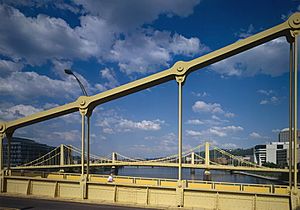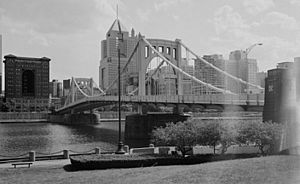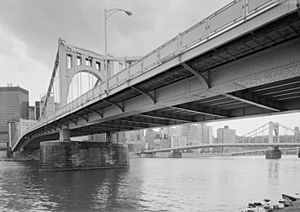Three Sisters (Pittsburgh) facts for kids
Quick facts for kids The Three Sisters |
|
|---|---|

View of Sixth, Seventh and Ninth Street Bridges from downriver
|
|
| Coordinates | 40°26′46″N 80°00′07″W / 40.44611°N 80.00194°W |
| Carries | 2 Vehicular lanes, 2 sidewalks |
| Crosses | Allegheny River |
| Locale | Pittsburgh, Pennsylvania |
| Maintained by | Allegheny County |
| Characteristics | |
| Design | Self-anchored suspension bridge |
| Designated: | 1988 |
| Sixth Street Bridge | |
|---|---|

From north bank of the Allegheny, downtown Pittsburgh in background
|
|
| Coordinates | 40°26′43″N 80°00′12″W / 40.44528°N 80.00333°W |
| Carries | Sixth Street |
| Official name | Roberto Clemente Bridge |
| Characteristics | |
| Total length | 884 feet (269 m) in main plus two 215 feet (66 m) side spans; 995 feet (303 m) with approaches |
| Width | 38 feet (12 m) roadway (formerly 2 vehicle, 2 tramway tracks, now 2 wide vehicle lanes) with 10 feet (3.0 m) sidewalks outside the plate girders |
| Longest span | 430 feet (130 m) |
| Clearance above | 78 feet (24 m) towers |
| Clearance below | deck is 40 feet (12 m) above Emsworth Dam normal pool level or 710 feet (220 m) above sea level |
| History | |
| Opened | October 19, 1928 |
The Three Sisters are three very similar bridges in downtown Pittsburgh, Pennsylvania. They cross the Allegheny River at 6th, 7th, and 9th streets. These bridges are special because they are the only group of almost identical bridges in the United States. They were also the first "self-anchored suspension bridges" built in America.
A self-anchored suspension bridge is a type of bridge where the main cables are attached to the ends of the bridge deck itself, instead of being anchored into the ground. This makes the bridge a complete, strong unit.
The Three Sisters bridges are named after famous people from Pittsburgh:
- The Roberto Clemente Bridge (Sixth Street Bridge) is named after a legendary baseball player.
- The Andy Warhol Bridge (Seventh Street Bridge) honors a famous artist.
- The Rachel Carson Bridge (Ninth Street Bridge) is named after an important environmentalist.
These bridges were designed by the Allegheny County Department of Public Works. They were all built between 1924 and 1928 by the American Bridge Company. They replaced older bridges that were not tall enough for ships to pass underneath. The bridges are made of steel and use strong steel "eyebars" instead of traditional cables.
Contents
Building Pittsburgh's Unique Bridges
The Three Sisters bridges are important in history. They are the only set of nearly identical bridges of their kind. They are also among the few remaining large bridges in America that use eyebar chains. Their special self-anchoring design was a smart solution for Pittsburgh in the 1920s.
The main engineers who designed these bridges were T. J. Wilkerson, Vernon R. Covell, and A. D. Nutter. Stanley L. Roush was the architect. The American Bridge Company built the top parts of the bridges, and the Foundation Company built the supports in the river. Allegheny County still owns all three bridges today.
A Look at Bridge History
Between 1926 and 1931, four large suspension bridges were built across the Allegheny and Monongahela Rivers in Pittsburgh. The Three Sisters are three of these bridges. The fourth bridge, the South Tenth Street Bridge, is different because it uses wire cables.
The design of the Three Sisters bridges was a clever way to solve several problems. Engineers had to meet strict rules about how high bridges needed to be above the river. They also had to consider how the bridges would look and how much they would cost. Plus, there wasn't much space on the riverbanks to anchor the bridges in the usual way. This is why the self-anchored design was so perfect.
The American Bridge Company, which built these bridges, was located nearby. The Foundation Company, which built the piers, was also local. This helped create jobs for people in the area.
How Suspension Bridges Work
| Seventh Street Bridge | |
|---|---|

From north bank of the Allegheny, looking SW, downtown Pittsburgh in background, Sixth Street Bridge at right. Shows main plate girder (bearing compressive forces) and sidewalk support
|
|
| Coordinates | 40°26′45″N 80°00′05″W / 40.44583°N 80.00139°W |
| Carries | Seventh Street |
| Official name | Andy Warhol Bridge |
| Characteristics | |
| Total length | 884 feet (269 m) in main plus two 221 feet (67 m) side spans; 1,061 feet (323 m) with approaches |
| Width | 38 ft roadway (formerly 2 vehicle, 2 tramway tracks, now 2 wide vehicle lanes) with 10 feet (3.0 m) sidewalks outside the plate girders; total 62 feet (19 m) |
| Longest span | 442 feet (135 m) |
| Clearance above | 83.5 feet (25.5 m) towers |
| Clearance below | deck is 40.1 feet (12.2 m) above Emsworth Dam normal pool level or 710 feet (220 m) above sea level |
| History | |
| Opened | June 17, 1926 |
A suspension bridge holds its roadway by hanging it from strong cables or chains. These cables pass over tall towers and are usually anchored into huge concrete blocks on the ground. This anchoring pulls the cables tight.
However, the Three Sisters are "self-anchored" suspension bridges. This means their cables are attached to the ends of the bridge deck itself. The deck acts like a giant beam that helps hold the cables in place. This design makes each bridge a strong, complete unit that doesn't need anchors on the riverbanks.
When these bridges were built, engineers debated if they were truly suspension bridges or another type called "cantilevers." Today, experts agree they are suspension bridges. Each bridge was built in two halves, starting from the riverbanks and meeting in the middle. Special temporary supports were used during construction. Once the two halves were connected, the bridge became a true suspension bridge.
| Ninth Street Bridge | |
|---|---|

From south bank of the Allegheny, looking NE, oblique view of roadway and south tower, showing eyebar links for main suspenders and roadway suspenders, as well as solid plate main compressive stiffening girders dividing roadway from sidewalks
|
|
| Coordinates | 40°26′47″N 79°59′59″W / 40.44639°N 79.99972°W |
| Carries | Ninth Street |
| Official name | Rachel Carson Bridge |
| Characteristics | |
| Total length | 840 feet (260 m) in main plus two 215 feet (66 m) side spans; 995 feet (303 m) with approaches |
| Width | 38 feet (12 m) roadway (formerly 2 vehicle, 2 tramway tracks, now 2 wide vehicle lanes) with 10 feet (3.0 m) sidewalks (outside the plate girders; total 62 feet (19 m) |
| Longest span | 410 feet (120 m) |
| Clearance above | 78 feet (24 m) towers |
| Clearance below | deck is 40.3 feet (12.3 m) above Emsworth Dam normal pool level or 710 feet (220 m) above sea level |
| History | |
| Opened | 26 November 1926 |
Why New Bridges Were Needed
One main reason all three bridges were built at the same time was that the old bridges didn't meet the rules set by the War Department. This department made sure that bridges over important rivers like the Allegheny were wide and tall enough for ships to pass safely.
The older bridges were owned by private companies. These companies made money by charging tolls to people who crossed the bridges. They were very profitable!
Over time, people in Pittsburgh wanted "free bridges." This meant they wanted the government to buy the bridges from the private companies and stop charging tolls. The county government bought these bridge companies before 1910.
Later, in the late 1910s, the War Department again said the bridges were not up to standard. The county needed to replace them. It took a while to get the money. Voters had to approve special bond issues to pay for big projects like bridges. These bond issues failed several times because people were worried about how public money was being spent.
Finally, in 1924, voters approved a large amount of money to improve bridges and other city structures. Many different bridge designs were suggested. The War Department insisted on a design that would always provide clear passage for ships. The old Seventh Street Bridge was torn down in 1924. The Ninth Street Bridge was also removed, even though it caused some trouble for the city.
After a lot of design work, two truss bridges and one cantilever bridge were approved. However, a group called the Metropolitan Art Commission vetoed these designs. They thought the bridges weren't pretty enough and preferred suspension bridges. But there wasn't much space on the riverbanks for the usual suspension bridge anchors. This is where the idea for the self-anchored design came in. The only other known example of this type of bridge at the time was in Germany.
Engineers like David B. Steinman had studied the strengths of the German bridge design. There was a big discussion among engineers about the best and safest types of bridges, especially after the Quebec Bridge collapsed twice (in 1907 and 1916). These accidents made many engineers prefer suspension bridges. Steinman wrote a book about suspension bridges, which likely helped the Allegheny County engineers learn about the self-anchored design.
Images for kids
-
From north bank of the Allegheny, downtown Pittsburgh in background
-
From north bank of the Allegheny, looking SW, downtown Pittsburgh in background, Sixth Street Bridge at right. Shows main plate girder (bearing compressive forces) and sidewalk support
-
From south bank of the Allegheny, looking NE, oblique view of roadway and south tower, showing eyebar links for main suspenders and roadway suspenders, as well as solid plate main compressive stiffening girders dividing roadway from sidewalks






